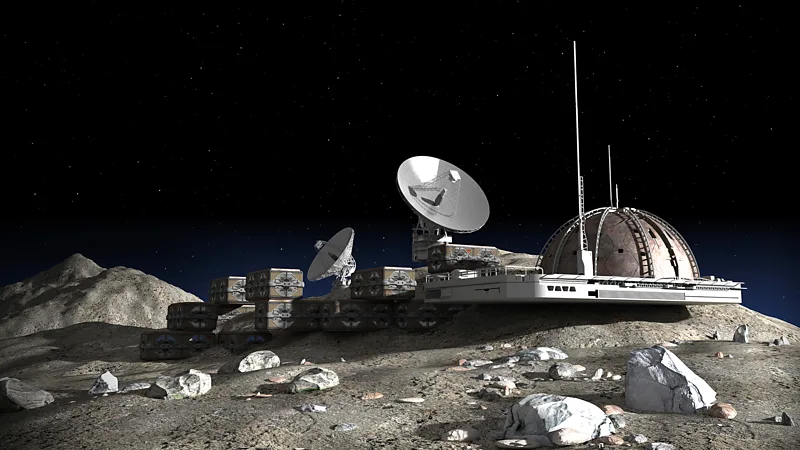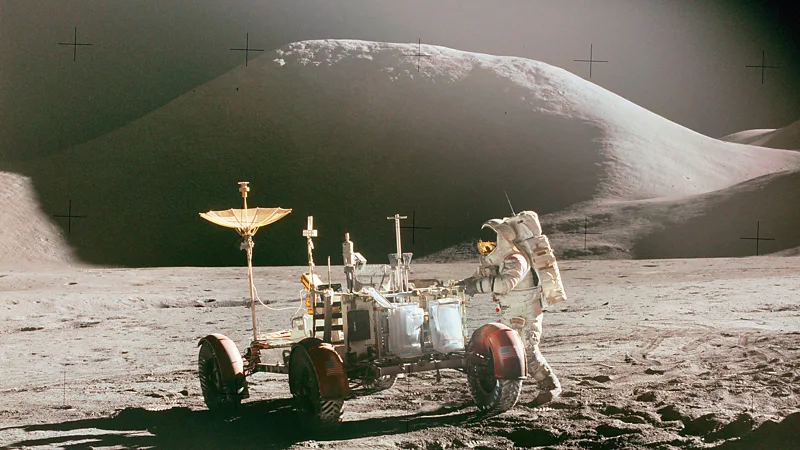The nuclear answer to moonbase power
 Astronauts stationed on the Moon will require substantial power sources, but transporting fuel supplies for conventional generators is impractical. A promising solution lies in the development of next-generation miniature nuclear reactors.
Astronauts stationed on the Moon will require substantial power sources, but transporting fuel supplies for conventional generators is impractical. A promising solution lies in the development of next-generation miniature nuclear reactors.
The popular 1970s TV series "Space: 1999" famously depicted a scenario where a nuclear explosion propels the Moon out of Earth's orbit, leading to the adventures of Moonbase Alpha. This fictional narrative appears to have influenced Elon Musk, who named SpaceX's envisioned Moon base "Alpha" in 2017. Today, SpaceX collaborates with NASA on the Artemis program, aimed at returning humans to the lunar surface. The proposed lunar outpost, however, is pragmatically titled "Artemis Base Camp."
Guidelines for peaceful lunar exploration have been jointly established by NASA and the US Department of State, known as the Artemis Accords. To date, 36 nations, including India, Japan, the UK, Canada, Australia, the United Arab Emirates, and South Korea, have endorsed these accords.
China is also at the forefront of lunar base development, with the announcement of the International Lunar Research Station in 2021. This initiative has garnered support from countries such as Russia, Belarus, Pakistan, Azerbaijan, Venezuela, Egypt, and South Africa.
Simon Middleburgh, from Bangor University's Nuclear Futures Institute in Wales, asserts that nuclear power is the sole viable option for powering a moon base, a conclusion reached by numerous companies and space agencies worldwide.
Nuclear Power: Essential for Lunar Exploration
 The lunar day, lasting approximately 29.5 Earth days, consists of two weeks of daylight followed by two weeks of darkness, with temperatures plummeting to as low as -130°C (-202°F). During the Apollo missions of 1969 to 1972, astronauts strategically landed during lunar days and near the Moon's equator to take advantage of manageable temperatures and prolonged sunlight to power scientific equipment and landers.
The lunar day, lasting approximately 29.5 Earth days, consists of two weeks of daylight followed by two weeks of darkness, with temperatures plummeting to as low as -130°C (-202°F). During the Apollo missions of 1969 to 1972, astronauts strategically landed during lunar days and near the Moon's equator to take advantage of manageable temperatures and prolonged sunlight to power scientific equipment and landers.
However, at the Moon's South Pole, where future lunar bases are likely to be situated, certain areas receive sunlight more than 80% of the time. Yet, temperatures in permanently shadowed craters can drop even further, potentially preserving frozen water deposits crucial for sustaining life and producing fuel. Given the absence of gas or oil on the Moon, nuclear power emerges as the most viable option.
Simon Middleburgh of Bangor University's Nuclear Futures Institute emphasizes the necessity of nuclear power, as traditional fuel sources and solar panels are impractical in the Moon's harsh conditions. Despite the use of radioisotope thermal generators during the Apollo missions, modern advancements in nuclear technology are required to meet the demands of lunar exploration.
To address this challenge, NASA awarded contracts in 2022 to companies such as Lockheed Martin, Westinghouse, and IX, a collaboration between Intuitive Machines and X-Energy.
These companies are tasked with developing lightweight and robust micro nuclear reactors capable of withstanding the lunar journey and operating effectively amidst the lunar surface's challenging environment, including the fine dust or regolith that blankets the terrain. Intuitive Machines, notably, achieved the first commercial soft landing on the Moon by a US company in over 50 years, demonstrating significant progress in lunar exploration technology.
Advancements in Lunar Nuclear Reactor Technology
 The first phase of developing a nuclear reactor capable of sustaining a habitable moon base for at least ten years concluded in February 2024 with the submission of reactor designs.
The first phase of developing a nuclear reactor capable of sustaining a habitable moon base for at least ten years concluded in February 2024 with the submission of reactor designs.
Shatel Bhakta, lead of the lunar architecture team at NASA's Johnson Space Center, expresses confidence in nuclear technology, drawing on its successful application in previous space missions like Pioneer, Voyager, and Cassini, where systems exceeded their original design life.
Designing a reactor for the lunar surface involves considerations such as harsh environments, minimizing mass and volume, ensuring high reliability, and providing uninterrupted power to ensure crew safety. Additionally, due to the significant distance from Earth and communication delays, the system must operate autonomously with minimal human intervention.
Last month, the Russian space agency, Roscosmos, announced plans to collaborate with the China National Space Administration to construct a lunar nuclear reactor by 2035 to power a joint moon base. The reactor will be built without human presence.
In March, the UK Space Agency allocated £2.9 million for the demonstration of a lunar modular nuclear reactor. Led by Rolls-Royce, known for its expertise in nuclear reactors for Royal Navy submarines, the collaboration between UK industry and academics aims to leverage this experience for space exploration purposes. Jake Thompson, Rolls-Royce's chief engineer for the Novel Nuclear program, emphasizes the company's extensive heritage in designing and manufacturing compact nuclear reactors, which it now applies to innovative domains like space exploration. Rolls-Royce's micro-reactor program is currently in the conceptual development phase, with testing underway on prototype components. The goal is to have a demonstration model ready for lunar delivery by 2029.
Rolls-Royce's micro-reactor program is currently in the conceptual development phase, with testing underway on prototype components. The goal is to have a demonstration model ready for lunar delivery by 2029.
According to Jake Thompson, these reactor systems are based on fission and will utilize low-enriched uranium. The design and weight of the systems have been extensively considered, with each micro-reactor expected to produce 50-100 kW of power and operate for at least a decade. The size of the reactor is scalable depending on the specific needs of lunar infrastructure, but it is envisaged to be roughly the size of a small family car and weigh a few tonnes.
Collaborating with the Nuclear Futures Institute, Rolls-Royce is focusing on miniaturization to ensure a successful design. Simon Middleburgh highlights the robustness of the nuclear fuel, which is based on Triso (TRi-structural ISOtropic) particles—a technology that has been under development in the UK for several years.
Middleburgh describes Triso particles as akin to a gobstopper, referencing the spherical, long-lasting candy with multiple layers. These particles encapsulate uranium within safety barriers, making them extremely robust and capable of withstanding high temperatures. The safety layers, including carbon graphite and silicon carbide, provide radiation tolerance and durability.
While the prospect of lunar micro-reactors generates excitement in the space industry, nuclear power on Earth is often associated with concerns about atomic bombs and the risks of radiation leaks or accidents, such as those at Chernobyl and Fukushima.
According to NASA's Bhakta, developing lunar power systems involves addressing various challenges, including natural and induced environmental factors such as launch vibrations, extreme temperatures, and lunar dust. These systems must be lightweight, reliable, and capable of withstanding the lunar environment for many years.
Thompson acknowledges the need to address worst-case scenarios, including the possibility of a spacecraft carrying radioactive material experiencing an explosion in Earth's atmosphere shortly after launch.
































